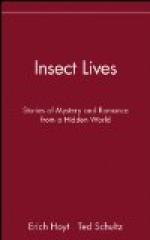The yearly cycle of the common Aphids of the apple tree has been lately worked out in detail by J.B. Smith (1900) and E.D. Sanderson (1902). In late autumn tiny wingless males and females are found in large numbers on the withered leaves. The sexes pair together, and the females lay their relatively large, smooth, hard-coated black eggs on the twigs; these resistant eggs carry the species safely over the winter. At springtide, when the leaves begin to sprout from the opening buds the aphid eggs are hatched, and the young insects after a series of moults, through which hardly any change of form is apparent, all grow into wingless ‘stem-mothers’ much larger than the egg-laying females of the autumn. The stem-mothers have the power, unusual among animals as a whole, but not very infrequent in the insects and their allies, of reproducing their kind without having paired[6] with a male. Eggs capable of parthenogenetic development, produced in large numbers in the ovaries of these females, give rise to young which, developing within the body of the mother, are born in an active state. Successive broods of these wingless virgin females (fig. 6 a) appear through the spring and summer months, and as the rate of their development is rapid, often the whole life-story is completed within a week. The aphid population increases very fast. Later a generation appears in which the thoracic segments of the nymphs are seen to bear wing-rudiments like those of the young cockroach, and a host of winged females (fig. 6_b_) are produced; these have the power of migrating to other plants. We understand that wings are not necessary to the earlier broods whose members have plenty of room and food on their native shoots, but that when the population becomes crowded, a winged brood capable of emigration is advantageous to the race.
[6] Such virgin reproduction is termed ‘parthenogenesis.’
Many generations of virgin female aphids, some wingless, others winged when adult, succeed each other through the summer months. At the close of the year the latest brood of these bring forth young, which develop into males and egg-laying females; thus the yearly cycle is completed. Variations in points of detail may be noticed in different species of aphids. The autumn males and egg-laying females are, for example, frequently winged, and the same species may have constantly recurring generations of different forms adapted for different food-plants, or for different regions of the same food-plant. But taking a general view of the life-story of aphids for comparison with the life-story of other insects, three points are especially noteworthy. Virgin reproduction recurs regularly, parthenogenetic broods being succeeded by a single sexual brood. A winged parent brings forth young which remain always wingless, and wingless adults produce young which acquire wings. The wings are developed, as in the cockroach, from outward and visible wing-rudiments.




